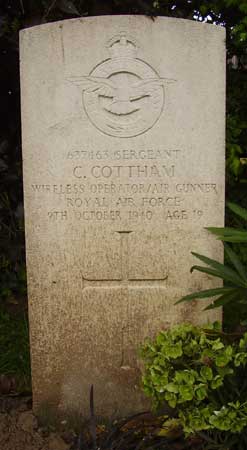Whitley N1410 damaged by flak, returned to Linton on Ouse airfield.
On the night of 10th / 11th September 1940 this 77 Squadron aircraft left Linton on Ouse at 23.05hrs tasked with bombing the docks at Bremen, it seems likely that the aircraft was hit by
flak before bombing as the pilot reported that controlling the aircraft became hard as he tried to make his bombing run. They released the bomb load and made for home but
maintaining height was recorded as being difficult in the squadron's ORB. They landed safely at 07.45hrs and an inspection of the aircraft soon found that a large section of
canvas on the port wing was missing, it had probably being torn away after a close flak burst just before the crew made their attack.
Pilot - Sgt Thomas Edward Coogan RAF (534642).
Second Pilot - P/O John Henry Nassau Molesworth RAFVR (80828).
Observer - P/O Geoffrey Donald Bailey RAF (44463).
Wireless Operator / Air Gunner - Sgt Cleveland Cottham RAF (637463).
Air Gunner - Sgt Smith.
Thomas Coogan was born in 1916 in Cheshire. Sgt Coogan crashed landed Whitley N1356 at Jurby on the Isle of Man on 8th June 1940 while on a training flight with 77 Squadron. He
was the second pilot of Whitley T4206 that crashed at Topcliffe on return from Ops to Stettin on 15th October 1940 and was slightly injured. He was awarded the DFM on 17th January
1941 for service with 77 Squadron and having completed his Tour he was later posted to 19 OTU but was sadly killed on 16th March 1942 flying Lysander R9120 when the aircraft crashed
onto Findhorn Beach, near Kinloss, killing him and Sgt Brian Phillips RAAF. He is buried in Kinloss Abbey Burial Ground.
Geoffrey Bailey received a commission on 20th August 1940 to the rank of P/O on probation. P/O Bailey was killed on 14th November 1940 while flying Ops to Berlin in Whitley
T4238, his aircraft was lost over Germany and he is now buried in Berlin War Cemetery. I thank Graham Sharpe for the photograph of his gravestone.
Sgt Cottham sadly died on 9th October 1940 when Whitley P5091 crashed at Snape, Yorkshire. He is buried at Topcliife Church Cemetery, Yorkshire and was just nineteen years old.

John Molesworth was born in September 1913 in the Maidstone area of Kent. He was granted a commission to the rank of P/O on probation on 15th June 1940, he was awarded the DFC
for service with 77 Squadron, Gazetted on 25th April 1941. He was later promoted to F/O (war subs) on 15th June 1941 and to F/Lt (war subs) on 15th June 1942. He was Mentioned in
Despatches on 14th January 1944. While in the rank of Acting S/Ldr he was awarded the Air Force Cross with a large number of higher ranked officers on 8th June 1944. He was then promoted to
S/Ldr (war subs) on 8th August 1944, while in the rank of Acting W/Co he was awarded the D.S.O. for service with 626 Squadron, Gazetted on 21st September 1945. He remained in the RAFVR
until he relinquished his commission on 24th September 1958.


Whitley N1410 was built to contract 75147/38 by Armstrong Whitworth Ltd. at Baginton and was awaiting collection on 30th October 1939 and was then issued to 77 Squadron at Driffield
in early November 1939 during the units conversion from Mk.IV Whitley's to Mk.V's. On 15th April 1940 it moved with the unit to Kinloss and then on 4th March back with the unit to
Driffield. On 4th June 1940 Cat.R/FB damage was recorded after it crashed on landing at Driffield. It's history refers to it being deemed beyond the capabilities of repair on site and
being dismantled and transported to Armstrong Whitworth Ltd. at Baginton for repair in works. It also states that officially on completion of these repairs in late 1940 it passed into MU
storage. This however must be not correct as it was still with 77 Squadron in September 1940 so the first repairs possibly were made on site and it was returned to the squadron. It was
damaged by flak on Ops on 11th September 1940 (recorded above) and was probably then sent for repair in works after the flak incident in September 1940, after repair it was issued to
19 OTU at Kinloss on an unknown date in 1941. It later transferred to 10 OTU at Abingdon on an unknown
date and coded "RK-Z" and served in the training role until being withdrawn from service; being flown to an MU store where it remained until being struck off charge on 16th August 1944.